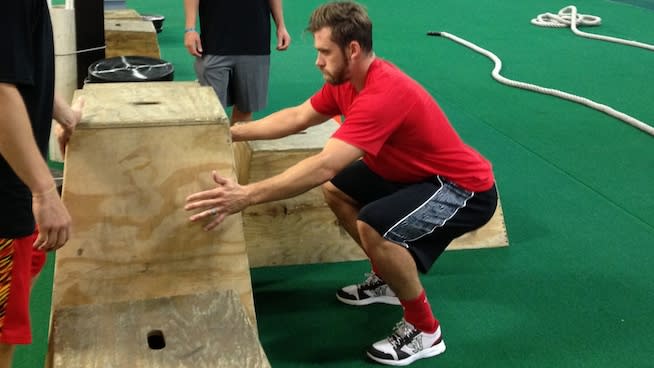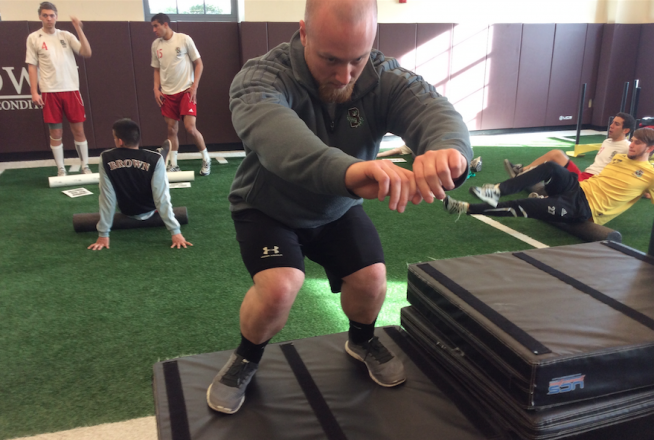3 Box Jump Mistakes That Can Ruin Your Vertical Jump

Temptation is a powerful thing. Tell athletes to be careful doing Box Jumps and they'll attempt kangaroo-like leaps to imitate the 50-inch jumping sensations they found on YouTube. Box Jumps have great carryover to athletic performance, but if performed incorrectly, they can cause catastrophic injuries.
Jump training should accomplish three things:
Develop force rapidly (i.e., explosiveness)
Absorb force rapidly (i.e., land softly in a stable position)
Replicate jumping motions used in sport
Unfortunately, three common mistakes often prevent athletes from accomplishing these training goals. Avoid these Box Jump mistakes for safer workouts, increased power and insane hops.
RELATED: 9 Ways Athletes Screw Up Common Exercises
Mistake 1: You Land in a Deep Squat
You see it all the time–athletes pull their knees to their ears and land in a full Squat with their butts touching their calves to nail a high jump.
You never saw Michael Jordan throw down a thunderous dunk with his knees pulled to his chest. Jumping power comes from hip extension, not hip flexion, so the goal of the exercise should be to move your center of mass as high as possible, not lift your knees up.
And if you land in a full squat, your muscles won't absorb the landing force properly. Instead, you'll beat up your joints and connective tissue, increasing the chance of injury.
Why It Happens: This one is simple. The box is too high! Master strength coach Mike Boyle has openly admitted having thrown out all the plyo boxes higher than 30 inches from his facility, because the risk of injury is far greater than the benefit of leaping onto extra-high boxes.
WATCH: Mike Boyle Discusses His Approach to Box Jumps
How to Fix It:
Use a box that allows you to jump and land in the same position, ideally a quarter- or half-squat. No one jumps from a full squat, so don't land in a full squat.
"Stick" every landing. Land softly but don't allow yourself to dip into a low squat. This teaches your hamstrings, glutes and hip muscles to absorb the landing force instead of your joints, tendons and ligaments.
Mistake 2: Your Knees Cave In
Stability is the number one component for a safe landing, and a knock-kneed position is as unstable as it gets. Plus, the action of the knees caving in—called valgus collapse—is the same mechanism that can cause an ACL injury.
For optimal safety and performance, land in a stable position with your knees tracking over your feet, your hips behind your knees and your weight distributed evenly throughout your foot.

Why It Happens: Valgus collapse happens for many reasons, most notably because of weak glutes, hamstrings and vastus medialis obliques (inner quad muscle). Females are especially prone to valgus collapse because of the wider angle between their hips and knees—hence the higher rate of female ACL injuries.
How to Fix It:
Practice perfect landing form. Start with a low box and imagine corkscrewing your feet into the ground as you land.
Strengthen the muscles that provide stability at the knee with exercises like Hip Thrusts, Glute-Ham Raises and Split Squats.
Mistake 3: You Jump Down from the Box
This one drives me absolutely crazy. Box Jumps are strenuous enough as it is, but jumping down from the box after each rep creates twice as many landings, twice as much stress on the body and twice as many chances to get hurt.
Why It Happens: The main reason is laziness, but many athletes simply don't understand the consequences of jumping down after each rep. Depth Jumps, an exercise where an athlete jumps down and lands from a high surface, place tremendous stress on the body—over five times an athlete's body weight with just a 30-centimeter drop (that's less than a foot). Only highly-trained athletes should perform Depth Jumps, and there's no need to add extra impact to a simple Box Jump.
How to Fix It:
After each rep, step down onto a slightly smaller box. If you're jumping to a 24-inch box, step down to a 12-inch box and then to the floor.
Hold yourself and your teammates accountable for weight room safety.
WATCH: Lacrosse Star Paul Rabil Performs Box Jumps
Practice Makes Permanent
Almost every athlete has to jump, so Box Jumps are as sport-specific as an exercise can get. But if you want to reap the benefits, you have to perform them correctly. Ask a teammate or a coach to watch your form and help you avoid these three Box Jump mistakes.
References:
Boyle, Mike. "The Idiot Box." Strengthcoach.com. 05 May 2009. Web. 06 Apr. 2014. .
Wallace, Brian J., Thomas W. Kernozek, James M. White, Dennis E. Kline, Glenn A. Wright, Hsien-Te Peng, and Chen-Fu Huang. "Quantification of Vertical Ground Reaction Forces of Popular Bilateral Plyometric Exercises." Journal of Strength and Conditioning Research 24.1 (2010): 207-12.
This article originally appeared on STACK.com: 3 Box Jump Mistakes That Can Ruin Your Vertical Jump

